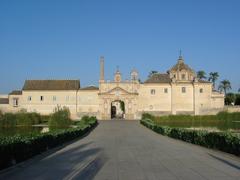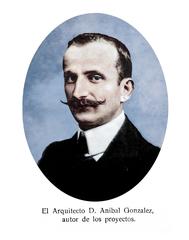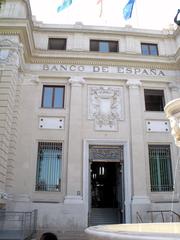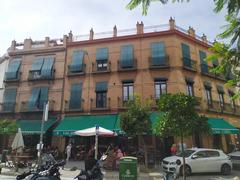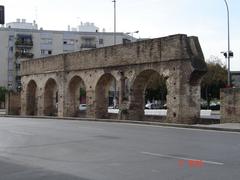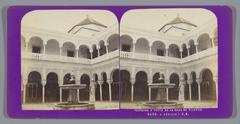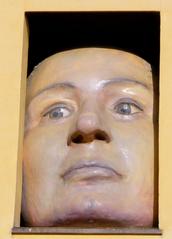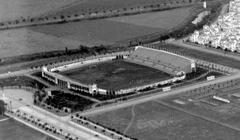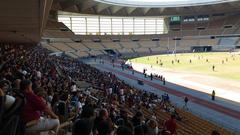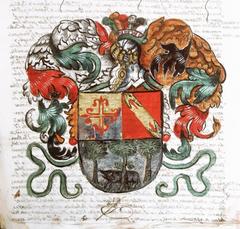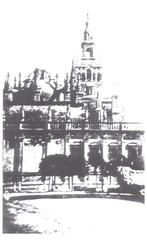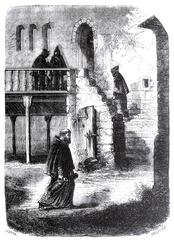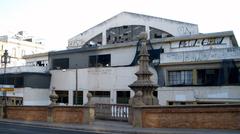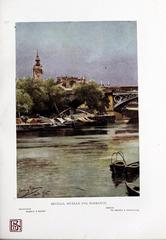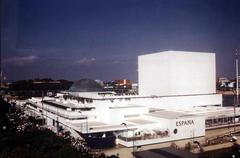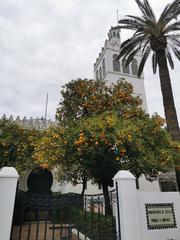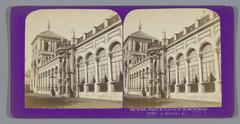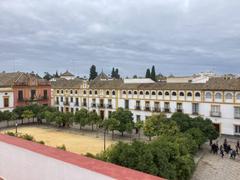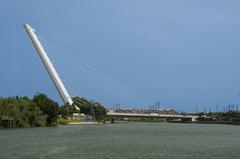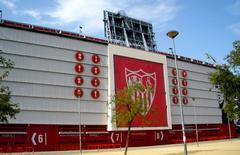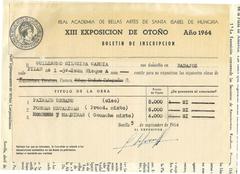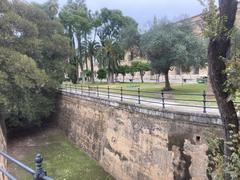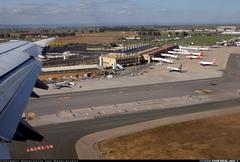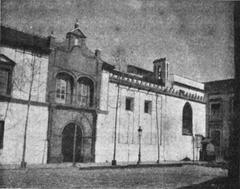Setas de Sevilla Visitor Guide: Hours, Tickets, and Tips
Date: 16/07/2024
Introduction
Seville, Spain, a city renowned for its rich history and vibrant culture, boasts an array of architectural marvels that seamlessly blend the ancient with the modern. Among these, the Setas de Sevilla, also known as the Metropol Parasol, stands out as a contemporary icon. Conceived in the early 2000s as part of an urban renewal project, this striking wooden structure was designed by German architect Jürgen Mayer H. and officially inaugurated in 2011 (ArchDaily). The Setas de Sevilla is not only an architectural feat but also a cultural and social hub, attracting millions of visitors annually. With its panoramic views, archaeological museum, and vibrant public space, it offers a unique experience that encapsulates the essence of Seville’s dynamic evolution. This guide delves into the history, architectural brilliance, cultural significance, and practical visitor information about the Setas de Sevilla, providing a comprehensive resource for anyone planning to explore this modern marvel.
Table of Contents
- [History of Setas de Sevilla](#history-of-setas-de-sevillahistory-of-setas-de-sevilla)
- [Origins and Conception](#origins-and-conceptionorigins-and-conception)
- [Architectural Competition and Design](#architectural-competition-and-designarchitectural-competition-and-design)
- [Construction Challenges](#construction-challengesconstruction-challenges)
- [Completion and Inauguration](#completion-and-inaugurationcompletion-and-inauguration)
- [Visitor Information](#visitor-informationvisitor-information)
- [Ticket Prices](#ticket-pricesticket-prices)
- [Opening Hours](#opening-hoursopening-hours)
- [Accessibility](#accessibilityaccessibility)
- [Travel Tips](#travel-tipstravel-tips)
- [Architectural Significance](#architectural-significancearchitectural-significance)
- [Cultural and Social Impact](#cultural-and-social-impactcultural-and-social-impact)
- [Archaeological Museum](#archaeological-museumarchaeological-museum)
- [Viewing Platform and Skywalk](#viewing-platform-and-skywalkviewing-platform-and-skywalk)
- [FAQ](#faqfaq)
- [Conclusion](#conclusionconclusion)
- [References](#referencesreferences)
History of Setas de Sevilla
Origins and Conception
The Setas de Sevilla, also known as the Metropol Parasol, is a striking wooden structure located in La Encarnación square in Seville, Spain. The idea for this modern architectural marvel was conceived in the early 2000s as part of an urban renewal project aimed at revitalizing the historic center of Seville. The project was initiated by the Seville City Council, which sought to transform the underutilized and deteriorating square into a vibrant public space.
Architectural Competition and Design
In 2004, an international architectural competition was held to select the design for the new structure. The competition attracted numerous entries from renowned architects around the world. Ultimately, the design submitted by German architect Jürgen Mayer H. was chosen. Mayer’s innovative design featured a series of interconnected wooden parasols that would provide shade and create a unique visual landmark in the heart of Seville.
Construction Challenges
The construction of the Setas de Sevilla was not without its challenges. The project faced numerous delays and budget overruns, which led to significant controversy and public debate. One of the primary challenges was the discovery of Roman ruins during the excavation phase. These archaeological findings required careful preservation and integration into the overall design of the structure. The construction process also faced technical difficulties due to the complex geometry and large scale of the wooden parasols.
Completion and Inauguration
After several years of construction, the Setas de Sevilla was finally completed in 2011. The official inauguration took place on March 27, 2011, and the structure was opened to the public. The completion of the project marked a significant milestone in the urban renewal efforts of Seville and provided the city with a new iconic landmark.
Visitor Information
Ticket Prices
To visit the Setas de Sevilla, tickets can be purchased at the entrance or online. Prices typically range from €3 to €5, with discounts available for seniors, students, and children. It is advisable to check the official website for the most up-to-date pricing information.
Opening Hours
The Setas de Sevilla is open to visitors daily. Opening hours are generally from 10 AM to 11 PM, although these may vary depending on the season or special events. It is recommended to verify the current visiting hours before planning your trip.
Accessibility
The Setas de Sevilla is designed to be accessible to all visitors. Elevators are available to reach the viewing platform, and the pathways are suitable for wheelchairs and strollers. The site also provides information and assistance for visitors with disabilities.
Travel Tips
- Best Time to Visit: Early morning or late afternoon to avoid crowds and enjoy the best lighting for photos.
- Nearby Attractions: Don’t miss the Seville Cathedral, the Giralda, and the Alcázar, all within walking distance.
- Dining: There are several cafes and restaurants in and around La Encarnación square where you can enjoy local cuisine.
Architectural Significance
The Setas de Sevilla is considered one of the largest wooden structures in the world. It stands at a height of approximately 26 meters and covers an area of 150 by 70 meters. The structure is composed of six large parasols, which are interconnected to form a continuous canopy. The design of the parasols is inspired by the vaults of Seville’s Cathedral and the ficus trees in the nearby Plaza de Cristo de Burgos.
The use of wood as the primary material for the structure is a notable feature of the Setas de Sevilla. The wooden elements are made from laminated timber, which provides strength and durability while maintaining a lightweight and flexible design. The structure also incorporates steel and concrete elements to ensure stability and support.
Cultural and Social Impact
Since its completion, the Setas de Sevilla has become a popular destination for both locals and tourists. The structure has transformed La Encarnación square into a vibrant public space that hosts various cultural events, markets, and social gatherings. The Setas de Sevilla has also contributed to the economic revitalization of the surrounding area, attracting new businesses and increasing foot traffic.
The structure’s design and construction have received international recognition and numerous awards. It has been praised for its innovative use of materials, its integration with the historic context of Seville, and its contribution to urban regeneration. The Setas de Sevilla has become a symbol of modern architecture and a testament to the city’s commitment to preserving its cultural heritage while embracing contemporary design.
Archaeological Museum
One of the unique features of the Setas de Sevilla is the archaeological museum located beneath the structure. During the excavation phase, significant Roman ruins were discovered, including remains of houses, mosaics, and pottery. These findings were carefully preserved and integrated into the design of the structure.
The archaeological museum, known as the Antiquarium, provides visitors with an opportunity to explore the rich history of Seville. The museum features a collection of artifacts and exhibits that showcase the city’s Roman past. Visitors can view the remains of ancient buildings and learn about the daily life and culture of the Roman inhabitants of Seville.
Viewing Platform and Skywalk
The Setas de Sevilla offers visitors a unique perspective of the city with its elevated viewing platform and skywalk. The viewing platform, located at the top of the structure, provides panoramic views of Seville’s historic center, including landmarks such as the Giralda, the Cathedral, and the Alcázar. The skywalk, a walkway that runs along the top of the parasols, allows visitors to experience the structure up close and enjoy breathtaking views of the city.
FAQ
What are the opening hours of Setas de Sevilla?
The Setas de Sevilla is generally open from 10 AM to 11 PM daily, but it’s best to check the official website for the most up-to-date hours.
How much are the tickets for Setas de Sevilla?
Ticket prices typically range from €3 to €5, with discounts available for seniors, students, and children.
Is the Setas de Sevilla accessible for visitors with disabilities?
Yes, the Setas de Sevilla is designed to be accessible for all visitors, including those with disabilities. Elevators and suitable pathways are available.
Conclusion
The Setas de Sevilla, with its innovative design, cultural significance, and historical integration, stands as a testament to Seville’s ability to blend the old with the new. It has become an iconic landmark that attracts visitors from around the world and serves as a vibrant public space for the people of Seville. The structure’s history, from its conception and construction to its impact on the city, highlights the importance of thoughtful urban planning and the preservation of cultural heritage. For the latest updates on visiting hours, ticket prices, and special events, be sure to visit the official website.
